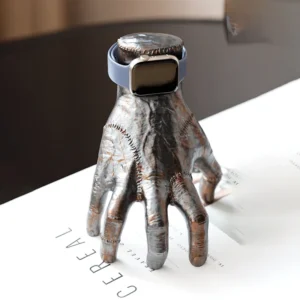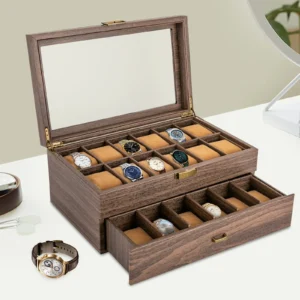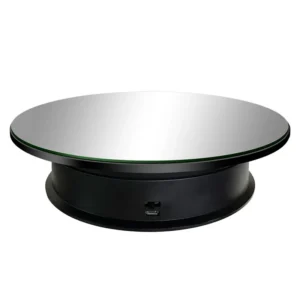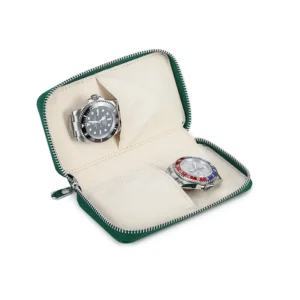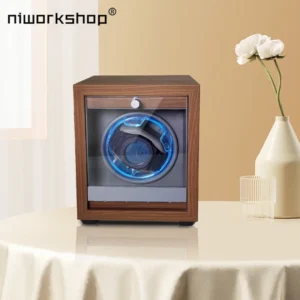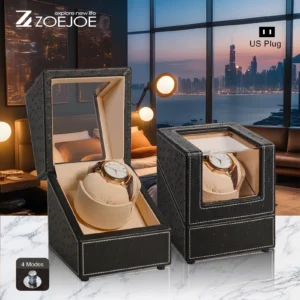Introduction
Fine watches represent more than just timekeeping devices—they’re investments, mechanical marvels, and often emotional attachments that deserve proper care. The materials used in your watch storage solution play a crucial role in preserving both the appearance and functionality of your timepieces for years to come. Whether you own a single cherished watch or a growing collection, the right storage materials can mean the difference between watches that deteriorate over time and ones that maintain their beauty and value.
Selecting the proper materials for watch storage isn’t merely about aesthetics—it’s about creating an environment that protects against scratches, dust, humidity, UV exposure, and other potential threats. Each component, from the exterior construction to the interior lining, serves a specific protective purpose.
In this comprehensive guide, we’ll explore the ideal materials for watch storage across various scenarios, helping you understand how material selection impacts long-term preservation. By the end, you’ll have the knowledge to make informed decisions about watch collection storage planning that aligns with your specific needs, whether you’re displaying your pieces, traveling with them, or storing them long-term.
Understanding Watch Storage Material Requirements
Before diving into specific materials, it’s important to understand exactly what we need from watch storage in terms of protection and preservation. The right storage materials must address several key requirements:
Physical Protection
* Protection from scratches on cases, bracelets, and crystals
* Dust prevention to keep movements clean and dials pristine
* Impact resistance to prevent damage during handling or transport
* Support that prevents stress on watch components
Environmental Control
* Humidity regulation to prevent moisture damage and corrosion
* Temperature stability to protect lubricants and mechanical components
* UV protection to prevent color fading on dials and straps
Practical Considerations
* Aesthetic appeal that complements your collection
* Durability appropriate for your usage patterns
* Weight and portability for your specific needs
* Breathability for mechanical watches that need air circulation
Your choice of materials should be influenced by several factors, including the value of your collection, how frequently you access your watches, and your local climate conditions. For instance, a collection of high-end mechanical watches in a humid climate requires different materials than a few quartz watches in a dry environment.
Understanding these requirements provides the foundation for making better material choices, which directly impact how well your watches are protected. Proper safe watch storage protection extends beyond simply placing watches in a container—it’s about creating an environment that actively preserves your timepieces.
Premium Wood: The Classic Choice for Watch Storage
Wood has long been the gold standard for premium watch storage, and for good reason. Its natural beauty, structural integrity, and inherent properties make it particularly well-suited for preserving timepieces.
Types of Wood and Their Properties
Mahogany: Prized for its rich, reddish-brown color and excellent dimensional stability. It’s less prone to warping over time, making it ideal for precision-fitted watch drawers and compartments.
Walnut: Offers exceptional durability combined with a naturally elegant dark appearance. Its density provides good protection against impacts while offering a sophisticated aesthetic.
Oak: Known for its strength and distinctive grain pattern. Oak’s natural tannins provide some resistance to moisture and insects, though it’s typically heavier than other wood options.
Cedar: Contains natural oils that repel insects and help regulate humidity. Cedar has traditionally been used in humidors and can offer similar benefits for watch storage, though it should be properly lined to prevent direct contact with watches.
Construction Considerations
The quality of wooden watch storage depends significantly on construction methods. Solid wood construction offers superior durability and stability compared to composite materials, though quality veneers over engineered wood can provide a good balance of stability and aesthetics at a more accessible price point.
One of the most significant advantages of wood is its natural ability to regulate humidity by absorbing and releasing moisture as environmental conditions change. This property helps create a more stable environment for your watches, particularly important for mechanical timepieces. However, this benefit is most pronounced in solid wood construction rather than thin veneers.
Wood finishes also impact performance. While lacquers create a sealed, protective surface, they can reduce wood’s natural humidity-regulating properties. Oil finishes allow the wood to breathe but may require more maintenance.
For collectors seeking the perfect balance of protection and presentation, our selection of wooden watch boxes offers various options crafted from premium hardwoods. Understanding the differences between best wood watch boxes can help you make the ideal choice for your collection.
Leather Materials: Versatility and Elegance

Leather represents a perfect marriage of protection and sophistication for watch storage. Its flexibility and variety of applications make it particularly versatile for different storage needs, from home display to travel.
Types of Leather for Watch Storage
Full-grain leather: The highest quality leather, made from the top layer of the hide with all natural grain intact. It develops a beautiful patina over time while providing excellent durability. Full-grain leather watch storage often becomes more attractive with age.
Top-grain leather: The second-highest quality, with the outermost layer sanded to remove imperfections. It offers good durability with a more uniform appearance than full-grain, striking a balance between quality and cost.
Saffiano leather: Features a distinctive cross-hatch pattern created through a special stamping process. The treatment adds remarkable scratch resistance and durability, making it ideal for travel watch cases.
Leather alternatives: Options like high-quality PU (polyurethane) leather or vegan leather can provide the aesthetic appeal of genuine leather with different properties. These alternatives often offer better water resistance and consistent texture.
Protective Qualities of Leather
Leather’s natural flexibility allows it to conform around watches, providing cushioned protection against impacts. The ideal thickness for watch storage applications is typically 1.2-2.5mm (3-6oz), offering sufficient structure while maintaining flexibility.
For travelers, leather watch rolls and cases offer an unmatched combination of protection and portability. The material absorbs minor impacts while being lightweight and compressible for packing. Our collection of leather watch travel cases features designs specifically engineered for secure transportation.
Leather’s primary limitation is its susceptibility to moisture and humidity changes. Without proper care, leather can dry out, crack, or develop mold in humid conditions. However, when properly maintained, leather watch storage develops character over time while continuing to protect your timepieces.
For those who appreciate traditional elegance, our leather watch boxes combine classic aesthetics with practical protection, offering varying configurations to accommodate collections of all sizes.
Synthetic and Modern Materials: Durability and Innovation
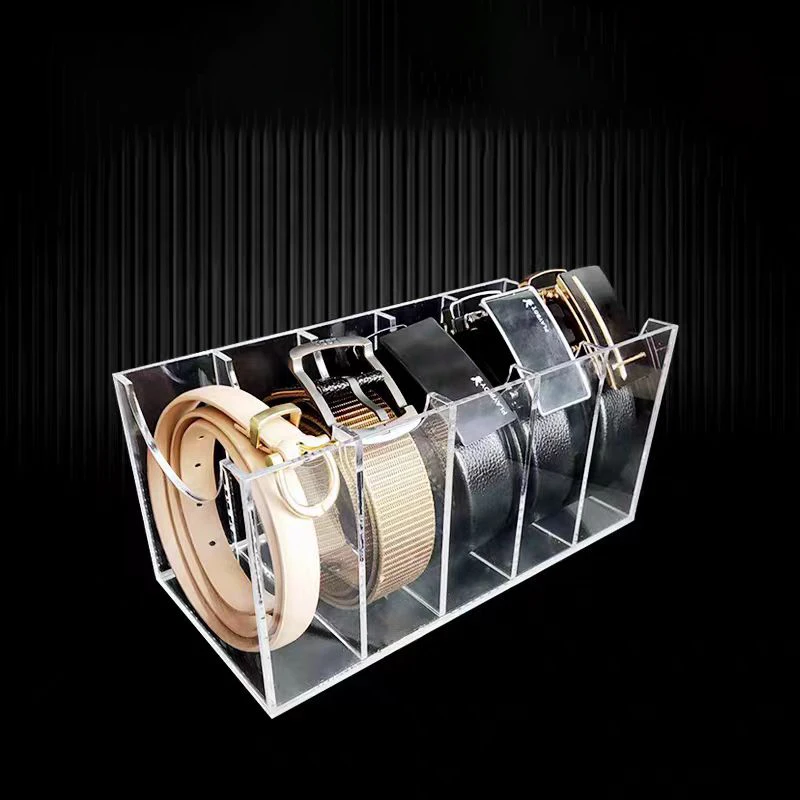
While traditional materials offer timeless appeal, modern synthetic materials have revolutionized watch storage with innovations that address specific protection challenges. These contemporary options often provide technical advantages that natural materials can’t match.
Advanced Materials for Superior Protection
Carbon fiber: Renowned for its exceptional strength-to-weight ratio, carbon fiber provides rigid protection while remaining incredibly lightweight. Its distinctive woven pattern also offers a contemporary aesthetic that appeals to collectors of modern sports watches.
Ballistic nylon: Originally developed for military body armor, this ultra-durable synthetic fabric offers superior tear and abrasion resistance. Watch cases made with ballistic nylon can withstand rough handling during travel while remaining lighter than leather alternatives.
Aluminum and metal: Provide superior impact protection and can incorporate locking mechanisms for security. Aluminum cases offer excellent protection-to-weight ratios and are often used in high-end travel cases where maximum protection is required.
ABS and polycarbonate: These engineering plastics deliver impact resistance and dimensional stability at affordable price points. Modern polycarbonate watch cases can withstand significant impacts that would damage traditional materials.
Protection Against Specific Threats
Synthetic materials often excel at addressing specific protection needs. For instance, certain engineered fabrics offer water resistance ratings of 600+ denier with DWR (Durable Water Repellent) treatments, providing substantial protection against moisture. Similarly, polycarbonate cases can feature IP67 water and dust resistance ratings, creating nearly hermetic environments for watches in extreme conditions.
These materials are particularly valuable for travelers and active collectors who need storage that can withstand varied environments. The technical properties of modern materials allow for innovations like pressure equalization valves in travel cases and antimicrobial treatments for interior components.
For collectors looking to display their pieces while maintaining protection, our watch display holders incorporate modern materials that balance visibility with preservation, creating striking presentation options with practical protection.
Interior Lining Materials: The Critical Protection Layer
The interior lining of your watch storage deserves special attention, as it’s the material in direct contact with your precious timepieces. Even the most beautiful exterior construction cannot compensate for poor interior materials that might scratch or damage watches.
Optimal Interior Materials
Velvet: The classic choice for premium watch storage interiors, velvet provides a soft, luxurious surface that cradles watches securely. Quality watch box velvet typically features a pile height of 1.5-2mm, dense enough to provide cushioning while remaining stable. Silk velvet offers the ultimate in softness, though synthetic velvets provide better durability and stain resistance.
Suede: Natural suede offers a soft, slightly textured surface that prevents watches from sliding while providing excellent scratch protection. Its slightly grippy texture is particularly useful in watch rolls or travel cases where movement must be minimized.
Microfiber: This synthetic alternative offers exceptional scratch prevention while being more durable and often more affordable than natural options. Premium microfiber with a density of 300-400 gsm (grams per square meter) provides excellent protection for watch crystals and polished surfaces.
Alcantara: A premium synthetic suede that offers the soft feel of natural suede with superior durability and stain resistance. Commonly used in luxury automotive interiors, it provides excellent protection with a premium feel.
Watch Cushions and Supports
The materials used in watch cushions are equally important. The ideal watch pillow provides gentle support without placing stress on bracelet links or leather straps. Memory foam cores wrapped in soft fabric offer ideal support, conforming to the watch’s shape without forcing bracelets into unnatural positions.
Our specialized watch pillows are designed with optimal materials to support watches of various sizes without stressing components, ensuring both protection and proper presentation.
Regardless of how impressive the exterior of your watch storage might be, never compromise on interior quality. The finest woods or leathers paired with abrasive or poor-quality interior materials will ultimately fail in their primary purpose of protecting your watches.
Material Selection for Different Storage Types
Different watch storage scenarios call for different material combinations. Here’s how to match the right materials to your specific storage needs:
Home Display Cases and Watch Boxes
For permanent display at home, solid hardwoods like walnut and mahogany excel due to their aesthetic appeal and stability. The weight of wood isn’t a concern for stationary storage, while its natural humidity-buffering properties benefit watches stored long-term. Interior linings should feature premium velvet or suede for maximum protection.
Glass or acrylic viewing panels allow appreciation of your collection while providing dust protection. Look for UV-resistant glass or acrylic to prevent dial fading if the display will be exposed to sunlight.
Travel Watch Rolls and Cases
Mobility demands different material priorities. Full-grain leather and ballistic nylon offer excellent protection while remaining lightweight and flexible. Interior materials should prevent movement during transport—suede and microfiber with slightly more texture work well here.
For extreme protection during travel, aluminum cases with foam interiors provide maximum security at the expense of added weight. Water-resistant zippers or seals are valuable additions for travel storage materials.
Watch Winders
Watch winders require materials that support quiet, stable operation. Solid wood constructions dampen motor vibration better than lightweight materials. Interior components should use static-resistant materials to prevent dust attraction, which can be particularly problematic with the slight electrical charge generated by winder motors.
Single Watch Pouches
For individual watches, soft materials like chamois leather or microsuede provide excellent protection with minimal bulk. These materials conform to the watch shape, providing cushioning without fixed structure.
Safe Storage Solutions
For watches stored in safes, materials must work within limited space while maximizing protection. Compact storage solutions using thin yet protective materials like neoprene can utilize space efficiently while still protecting watches from contact with each other.
The size and nature of your collection will influence optimal material choices. Small collections might benefit from display-oriented materials, while larger collections may prioritize efficient use of space with more compact materials. Developing thoughtful watch storage ideas for collectors and understanding how to compare types of watch storage can help you make optimal choices for your specific situation.
Environmental Considerations for Watch Storage Materials
The interaction between storage materials and environmental conditions directly impacts how well your watches are preserved over time. Different materials respond to environmental challenges in distinct ways:
Humidity Control
Uncontrolled humidity represents one of the greatest threats to watches, potentially causing corrosion on movement components and damage to dials and hands. The ideal relative humidity range for watch storage is 40-60%.
Solid woods, particularly cedar and mahogany, naturally absorb and release moisture, helping to buffer against humidity fluctuations. However, this property is significantly reduced in heavily lacquered or sealed wood. In contrast, most synthetic materials and metals don’t offer humidity regulation.
For enhanced humidity control, some premium watch boxes incorporate discreet compartments for silica gel or other moisture-absorbing materials. These can be particularly important for storage in high-humidity environments.
Temperature Regulation
Extreme or fluctuating temperatures can damage watch lubricants and affect timing accuracy. Materials vary in their thermal insulation properties:
- Wood provides natural insulation against temperature fluctuations
- Metal quickly conducts temperature changes to the interior
- Synthetic foams offer excellent thermal insulation
Material Degradation Concerns
Some storage materials can themselves pose risks to watches. Low-quality synthetics may release volatile organic compounds (VOCs) that could potentially affect watch components over time. Similarly, certain adhesives used in construction can off-gas and cause issues in enclosed storage spaces.
Premium watch storage uses stabilized materials and non-toxic adhesives to ensure no harm comes to watches even during long-term watch storage protection. Quality manufacturers test materials for off-gassing and use only watch-safe components.
Breathability Considerations
Mechanical watches benefit from some air circulation, particularly to prevent condensation if temperature changes occur. Completely sealed environments can sometimes do more harm than good. The ideal watch storage materials allow minimal air circulation while still providing dust protection.
For collectors in extreme climates (very humid tropical environments or very dry desert conditions), material selection becomes even more critical, and additional environmental control measures may be necessary regardless of storage material choices.
Material Quality and Authentication
Identifying quality materials in watch storage products requires attention to specific details:
Wood Quality Indicators
* Consistent grain patterns with proper matching across panels
* Substantial weight that indicates solid construction rather than veneers
* Smooth, even finishing without rough spots or visible filler
* Tight, precise joinery at corners with no gaps
Leather Authentication
* Natural variations in texture and color (perfectly uniform appearance often indicates synthetic materials)
* Rich, natural scent without chemical odors
* Edge finishing that reveals the cross-section of natural leather layers
* Develops patina with handling rather than simply wearing away
Synthetic Material Quality
* Consistent texture and color throughout the product
* Proper reinforcement at stress points
* Hardware that’s securely integrated without pulling or stretching
* Resistant to light scratching without immediate damage
Interior Lining Evaluation
* Even application without bunching or gaps
* Secure attachment with no loose edges
* Colorfast (test by rubbing with white cloth—no color should transfer)
* Consistent pile direction in velvet or suede
The relationship between material quality and long-term protection cannot be overstated. Premium materials maintain their protective properties over years of use, while inferior materials may degrade rapidly, potentially damaging the very watches they’re meant to protect.
When evaluating watch storage products, pay special attention to craftsmanship details like stitching regularity, hardware quality, and interior finishing. Understanding key features to look for in watch organizers will help you make an informed purchase decision that ensures proper protection for your collection.
What Materials to Avoid for Watch Storage
Just as important as knowing the best materials is understanding what to avoid. Some materials pose direct risks to your watches:
Potentially Harmful Materials
Low-quality plastics: Can release chemicals that may damage watch finishes and potentially even affect movement components over time. Particularly concerning are plastics with strong odors, which often indicate high levels of volatile compounds.
Untreated metals: Direct contact between watches and untreated metals can cause galvanic corrosion where dissimilar metals interact. This is especially problematic for storage of watches with precious metal cases.
Acidic woods: Some woods naturally contain higher acid content that can potentially damage watches over extended periods. Red oak, for example, contains tannic acid that could theoretically affect watch components if not properly sealed or lined.
Abrasive fabrics: Materials with rough textures or loose fibers can scratch polished surfaces or work their way into watch movements through microscopic openings in the case.
High-VOC materials: Products with strong chemical smells often contain volatile organic compounds that can off-gas over time, potentially affecting watches stored in close proximity.
The potential damage from these materials isn’t always immediately apparent. Problems may develop gradually over months or years of storage, making material selection a critical long-term decision.
Common misconceptions include the belief that any wood is automatically safe for watch storage (untreated or unsealed woods can sometimes release acids or attract moisture) and that leather is universally gentle (poorly tanned leather can contain residual chemicals that might affect watch metals).
When in doubt, opt for watch storage products specifically designed for timepieces rather than repurposing generic storage containers that might contain watch-unfriendly materials.
Watch Accessories, Watch Holder
$94.51 Select options This product has multiple variants. The options may be chosen on the product pageMen's Watch Organizer, Watch Display Case, Watch Organizer
Price range: $112.68 through $169.45 Select options This product has multiple variants. The options may be chosen on the product pageRotating Watch Holder, Watch Holder
Price range: $93.28 through $93.35 Select options This product has multiple variants. The options may be chosen on the product pageLeather Watch Travel Case, Men's Watch Travel Case, Watch Roll Travel Case
Price range: $91.37 through $92.63 Select options This product has multiple variants. The options may be chosen on the product pageAutomatic Watch Winder, Single Watch Winder, Wooden Watch Holder
$201.76 Select options This product has multiple variants. The options may be chosen on the product pageAutomatic Watch Winder, Leather Watch Travel Case, Single Watch Winder
$146.30 Select options This product has multiple variants. The options may be chosen on the product page
Material Care and Maintenance for Longevity
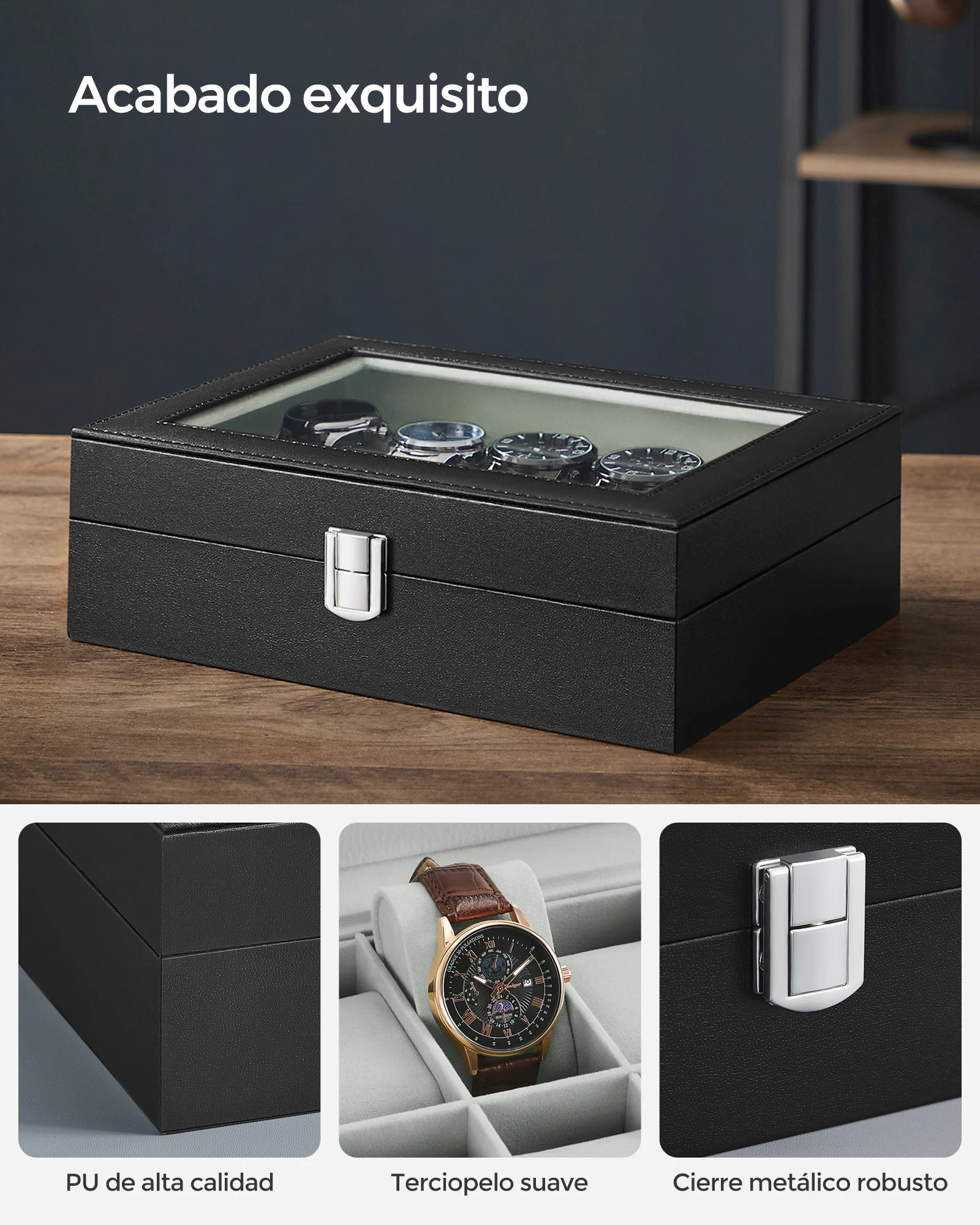
Proper maintenance of your watch storage materials ensures they continue providing optimal protection for years to come. Different materials require specific care approaches:
Wood Care Guidelines
* Maintain consistent humidity levels (40-60% relative humidity)
* Clean with a slightly damp microfiber cloth, avoiding excess moisture
* Apply quality furniture polish specifically formulated for the wood type every 3-6 months
* Keep wooden watch boxes away from direct sunlight to prevent fading and drying
Leather Maintenance
* Clean leather surfaces with a soft, dry cloth regularly
* Apply quality leather conditioner every 3-4 months to prevent drying and cracking
* Keep leather storage away from high humidity areas to prevent mold
* Allow leather to breathe—avoid storing in plastic bags or air-tight containers
Synthetic Material Care
* Clean with mild soap and water, avoiding harsh chemical cleaners
* Dry thoroughly after cleaning to prevent moisture buildup
* Keep away from high heat sources that could deform synthetic materials
* Check hardware and zippers regularly, applying lubricant to zippers if needed
Interior Fabric Maintenance
* Vacuum gently with a soft brush attachment to remove dust
* Remove spots immediately with appropriate fabric cleaner
* For velvet or suede, brush periodically to maintain nap direction
* Use lint rollers for quick cleaning of interior compartments
Establishing a regular maintenance schedule for your watch storage preserves both appearance and functionality. Quality materials respond well to proper care, often looking better with age, particularly woods that develop richer patinas and leathers that become more supple with proper conditioning.
Even damaged watch storage can often be restored or repaired. Leather can be reconditioned, wood refinished, and interior linings replaced by skilled craftspeople. Investing in maintenance extends the protective qualities of your watch storage, ultimately providing better protection for your timepiece collection.
How to Make an Informed Material Choice
With so many material options available, making the right choice for your specific needs requires a systematic approach:
Decision Framework
Primary Consideration – Collection Value and Type:
* High-value automatic watches generally warrant investment in premium materials with superior humidity control
* Sports watches used actively may benefit from more durable, water-resistant storage materials
* Vintage watches often require more attention to stable environmental conditionsSecondary Consideration – Usage Pattern:
* Daily rotation users need easy access and may prioritize display features
* Travelers should emphasize durability and portability in materials
* Long-term storage requires materials with stability and environmental controlTertiary Consideration – Environmental Factors:
* High-humidity environments demand materials with moisture resistance or regulation properties
* Very dry climates may require materials that help maintain minimal humidity
* Exposure to sunlight necessitates UV-resistant materials
When evaluating material claims from manufacturers, look for specific technical details rather than generic claims. Terms like “premium” or “luxury” mean little without substantiating information about material sources, construction methods, and protective properties.
Budget considerations should focus on value rather than simply initial cost. Higher-quality materials generally provide better protection and longer service life, offering better long-term value despite higher initial investment. The protection requirements should always be proportional to the value of the watch collection—a $10,000 watch deserves better than a $20 storage solution.
Does Wood Really Offer Better Humidity Control?
Wood’s reputation for humidity regulation is widely accepted among watch collectors, but the reality contains important nuances. Wood is indeed hygroscopic, meaning it absorbs and releases moisture as environmental conditions change. This property can help buffer against rapid humidity fluctuations that might otherwise affect watches.
Research has shown that solid hardwoods can absorb approximately 10-12% of their weight in moisture, effectively acting as natural humidity regulators. However, this property varies significantly depending on:
- Wood thickness (thinner veneers offer minimal regulation)
- Surface treatments (heavily sealed woods lose much of this property)
- Wood species (some woods are more hygroscopic than others)
Untreated solid wood provides the most effective humidity regulation, but it may be less aesthetically refined than treated options. Conversely, highly finished woods offer beautiful appearance but reduced humidity control.
In practical terms, wood does provide humidity benefits in moderate climates with minor fluctuations, but it cannot completely protect watches in extreme conditions. For serious collectors in challenging climates, wood storage should be supplemented with dedicated humidity control solutions like silica gel packets or electronic humidity regulators.
Are Synthetic Materials Ever Better Than Natural Ones?
While traditional materials carry prestige and proven track records, modern synthetic materials often provide technical advantages in specific scenarios:
Travel Protection Superiority
Modern synthetic cases can achieve impact resistance ratings that natural materials simply cannot match. High-end travel cases using polycarbonate or reinforced polymers can protect watches against drops that would damage traditional materials.
Consistency and Quality Control
Synthetic materials offer manufacturing consistency impossible with natural materials. This uniformity ensures predictable protective properties without the variations inherent in wood or leather.
Specific Protective Properties
Some synthetic materials offer protection against threats that natural materials cannot address:
* UV-resistant polymers prevent light damage better than most natural materials
* Water-resistant synthetics provide protection levels measured in standardized ratings (IPX ratings)
* Anti-static materials protect against electromagnetic interference
Hybrid Solutions
Many premium watch storage products now combine natural and synthetic materials to maximize benefits—exterior wood or leather for aesthetics and tradition, with interior synthetic components engineered for specific protective properties.
Environmental considerations also merit attention. Sustainably harvested woods and vegetable-tanned leathers often have lower environmental impacts than petroleum-based synthetics, though high-quality synthetics may offer longer service life.
The ideal approach recognizes that neither natural nor synthetic materials are universally superior—each has specific advantages for particular storage scenarios. The best choice depends on your specific needs, usage patterns, and the watches being stored.


